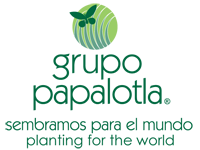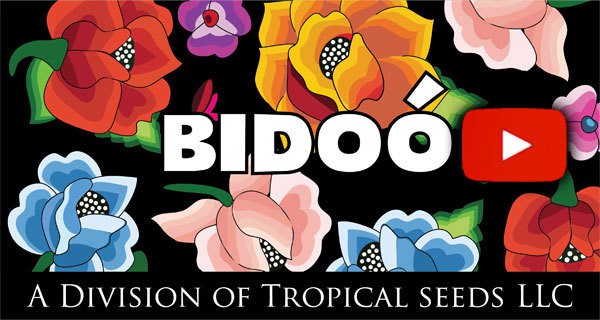-
International
With a presence in Asia, Africa, Australia and the Pacific, the Caribbean, and the United States; working with both small farmers and large enterprises we are never too far from your needs. -
-
TROPICAL SEEDS, LLC
2175 NW 24TH AVE.
MIAMI, FLORIDA 33142-7279
USA
Phone: +1 954 7536301
-
Desmodium
Desmodium intortum cv. Desmodium
Scientific nameDesmodium intortum (Mill.) Urb.
Synonyms:
Desmodium hjalmarsonii (Schindl.) Standl.
Desmodium trigonum DC.
Hedysarum intortum Mill. [basyonim]
Meibomia hjalmarsonii Schindl.Desmodium Family/tribe
Family: Fabaceae (alt. Leguminosae)
subfamily: Faboideae
tribe: Desmodieae
subtribe: Desmodiinae.
Also placed in: Papilionaceae.Common names
greenleaf desmodium, beggarlice (English);
grünes desmodium (German);
desmodio hoja verde, pega pega, amor seco (Spanish);
desmodie (French);
karikuy-ritkuk (Philippines);
thua kleen leap (Thailand).Morphological description
Greenleaf desmodium is a large trailing and scrambling perennial. It has a strong taproot and the long trailing stems can root at the nodes if in contact with moist soil. These stems are grooved, hairy and reddish-brown in colour and branch freely; it is finer and less hairy than ‘Silverleaf’ (D. uncinatum ). The trifoliate leaflets, to 7 cm x 5 cm, have reddish-brown flecking on the upper surface. Although pointed, they are more round than those of D. uncinatum. The deep pink flowers are produced on a compact terminal raceme ; they develop to narrow segmented pods to 5 cm long, holding 8–12 seeds. The segments break up when mature and, being covered with short hooked hairs, will stick to hair or clothing. There are c. 595,000 seeds per kg.
Distribution
Native to:
Mesoamerica: Belize, Costa Rica, El Salvador, Guatemala, Honduras, Mexico, Nicaragua, Panama.
Caribbean: Hispaniola, Jamaica, Puerto Rico.
South America: Colombia, Ecuador, Peru, Venezuela, and in a restricted area of Brazil between 18 and 25°S.Desmodium now naturalised in small areas of higher altitude tropics and the humid subtropics
Uses/applications
Desmodium used for long-term pastures although it rarely persists permanently. It is also used in irrigated pastures, for conservation as hay and silage , for cut-and-carry systems, and as ground cover where the abundant leaf fall and slow decomposition result in a deep duff layer under the plants.
Ecology
Soil requirements
Desmodium will grow on a wider range of soils than will D. uncinatum , from sands, light loams to medium clays, but prefers moderate fertility and pH above 5.0. It is not tolerant of salinity or high Al and Mn.
Moisture
It generally requires more than 900 mm rainfall with a moderate dry season of less than 6 months, but will grow under much wetter conditions (>3,000 mm) outside of South America. Tolerance to waterlogging or flooding is better than D. uncinatum. It wilts less readily than ‘Silverleaf’ but will drop leaf under extended dry conditions. In Zimbabwe, ‘Silverleaf’, with its stronger taproot, proved decidedly more drought tolerant than ‘Greenleaf’.
Temperature
This is a warm season plant but for cooler climates, e.g. at moderate altitudes in the tropics and low altitudes in the subtropics rather than lowland tropics. Desmodium starts growing later in spring than ‘Silverleaf’, but withstands hot weather better than D. uncinatum . Grows well into the cooler season although frost-susceptible.
Optimum growth at 30/25°C ±3°C.
Light
D. intortum has good shade tolerance.
Reproductive development
It has a sensitive short-day control of flowering, which is restricted to mid May-early June in the southern hemisphere. However, temperature as well as daylength controls flowering in D. intortum . At similar latitudes, plants at higher altitudes flower earlier.
Defoliation
Mature plants cannot stand constant heavy grazing or frequent heavy defoliation in which the growing points are removed; heavy stands are soon reduced to very small individual plants. Adjust grazing pressure to retain bud sites and leaf material. Even under careful grazing management, few pastures of D. intortum persist for more than 6 years.
Fire
It does not like fire but will sprout again from the rootstock.
Agronomy
Establishment
Green-leaf desmodium has small seed resulting in slow seedling growth. It is usually established into a prepared seedbed, but it can be planted vegetatively from rooted cuttings. Oversowing seed into established pasture is not reliable because of slow seedling growth.Machine harvested seed has a low proportion of hard seed due to mechanical abrasion but hand harvested seed may need scarification .
Seed should be inoculated with specific rhizobia (CB 627 in Australia) prior to sowing.
Fertilizer
It requires moderate levels of fertility and phosphorus, sulphur, potassium and molybdenum may need to be applied.
Compatibility (with other species)
Combines well with tussock grasses and will climb over small scrubs. Because it is adapted to cooler climates, it is often grown with subtropical grasses, eg. Setaria.
Companion species
Grasses: Setaria sphacelata , Pennisetum clandestinum , pangola (Digitaria eriantha ). It will also combine with Panicum maximum and Pennisetum purpureum .
Legumes: Macroptilium atropurpureum , Neonotonia wightii
Pests and diseases
Stands in Australia have been severely attacked by the root-eating Amnemus weevil. Leaf fungus can affect stands under high rainfall conditions, especially in Central America.
Ability to spread
It will spread into ungrazed shady areas through the rooting stolons
Weed potential
Possible weed of riparian vegetation due to its ability to climb and its shade tolerance.
Feeding value
Nutritive value
D. intortum leaf has high protein content but also contains condensed tannins. In vitro digestibility ranges from 52.5–56.6% in reasonably young regrowth, but is at least 10 units less at all stages and in all parts than siratro (Macroptilium atropurpureum ). Late flowering allows it to provide carryover feed later in autumn than ‘Silverleaf’.
Palatability/acceptability
Not particularly palatable because of high tannins, but enough that it requires careful grazing management to persist
Toxicity
No toxicity recorded and no bloat.
Production potential
Dry matter
DM yields of 12–19 t/ha have been recorded.
Animal production
LW gains have exceeded 500 kg/ha/yr off grass legume pastures using Panicum maximum or Digitaria eriantha.
Genetics/breeding
Self-fertile but flowers may require tripping for pollination and good seed set.
Seed production
Flowers later than D. uncinatum and is thus a less reliable seed producer in areas where early frosts may occur during flowering or seed maturation. Mechanical harvest is made difficult by uneven ripening of the seed and the sticking nature of the seed pods which can ‘ball-up’. Stands are windrowed and left to dry for 2 weeks before being threshed by a pick-up harvester using the highest possible drum speed and close concave settings. Yields of 80–100 kg/ha seed are common, although much higher yields have been reported from northern Natal, South Africa.
Herbicide effects
Seedlings show good tolerance to the herbicide 2, 4-D; mature plants are reasonably tolerant of the desiccant diquat.
Strengths
· Good early and late season vigour.
· Shade tolerant.
· Combines with tussock and creeping grasses.
Limitations
· Low seedling vigour.
· Poor persistence under heavy grazing.
· Susceptibility to pests.
· Poor tolerance of drought and salinity
________________________________________________________________________
[1] TEXT TAKEN FROM:
http://www.tropicalforages.info/key/Forages/Media/Html/Desmodium_intortum.htm
VIDEO: Mulato II associated with Desmodium Intortum as Animal Feed-
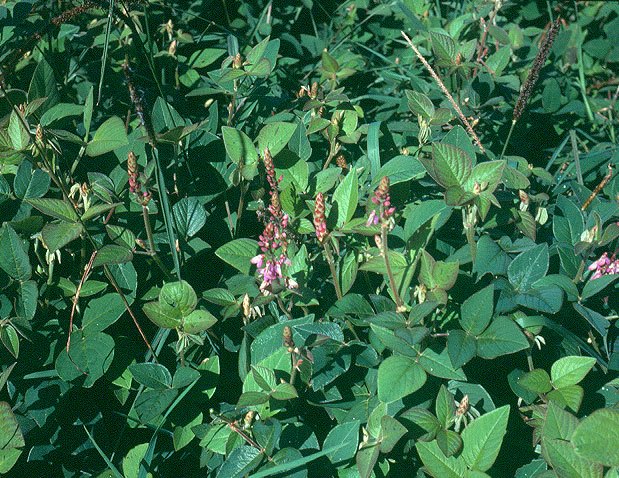
Desmodium Intortum leaves and flower
-
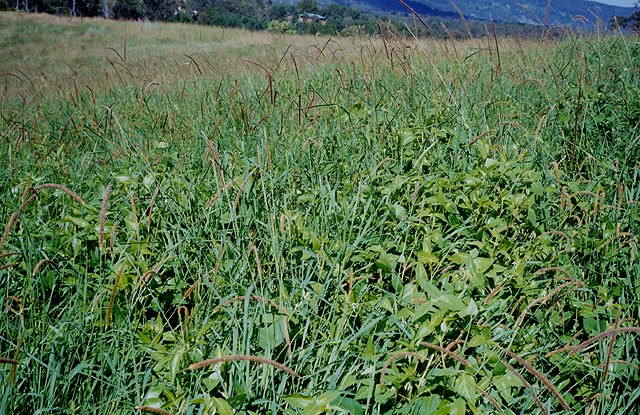
Desmodium Intortum field
-
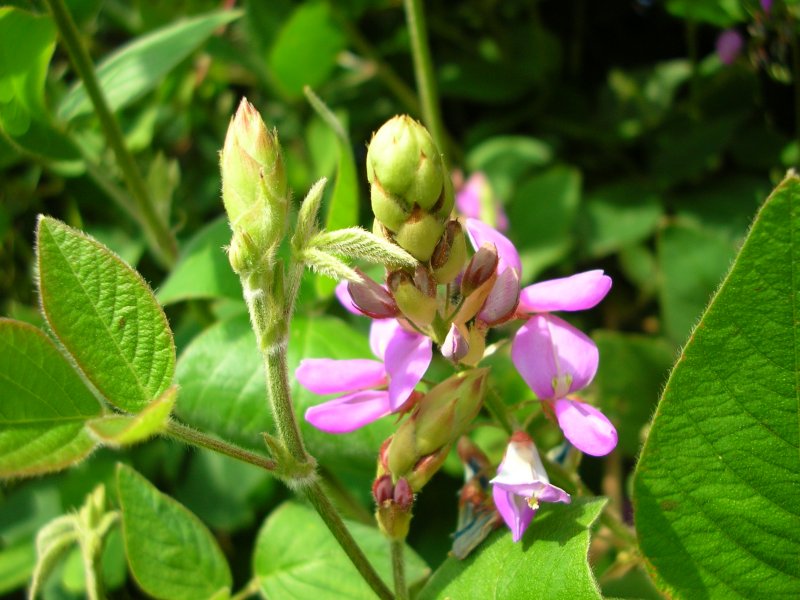
Desmodium Intortum flower and bud
-
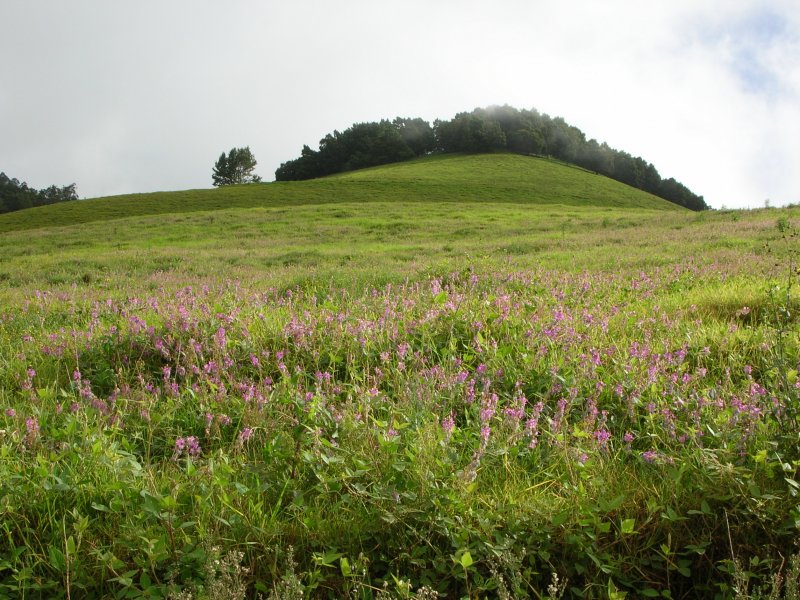
Desmodium Intortum field in blossom
-
-
TROPICAL SEEDS, LLC
2175 NW 24TH AVE.
MIAMI, FLORIDA 33142-7279
USA
Phone: +1 954 7536301

